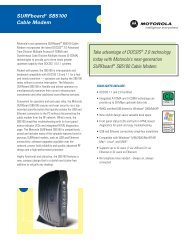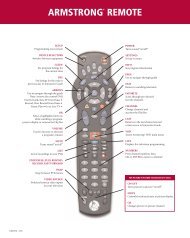PACE Tahoe TDC775HD User Guide (PDF) - Armstrong
PACE Tahoe TDC775HD User Guide (PDF) - Armstrong
PACE Tahoe TDC775HD User Guide (PDF) - Armstrong
Create successful ePaper yourself
Turn your PDF publications into a flip-book with our unique Google optimized e-Paper software.
CONNECTING THE EQUIPMENT (cont.)<br />
About Set-up C: Using an HDMI cable to connect a TV and S-video cable to connect<br />
a VCR<br />
In this set-up, a VCR is added to the basic set-up. The way in which you connect the HDTV to the<br />
set-top (either HDMI or component video) does not affect the way you connect the VCR. Therefore<br />
an HDMI connection between the set-top and the TV is shown on page 20. (It could be component<br />
video instead).<br />
• If the VCR and HDMI TV have S-video connectors, use S-video cables (4 and 5), as this gives a<br />
better quality picture. If there are no S-video connectors, use the baseband video jacks and<br />
video 75 ohm coaxial cables.<br />
• Use baseband audio jack cables: cable 6 (from the set-top’s PRIMARY AUDIO OUT jacks) and<br />
cable 7 (between the VCR and the HDMI TV).<br />
• The path for recording on the VCR is cables 6 (baseband stereo audio) and cable 4 (S-video) (or<br />
via baseband video jacks).<br />
• The path for playing back from the VCR is cables 7 (baseband stereo audio) and cable 5 (Svideo)<br />
(or via baseband video jacks).<br />
• If the HDTV has only one pair of baseband audio input jacks and you are using them to connect<br />
the set-top to the HDTV (for example, if you are using component video, rather then HDMI),<br />
you can connect the baseband audio cables (7) from the VCR to the AUDIO IN jacks on the<br />
set-top. The audio then loops through the set-top when the VCR is playing back. The set-top<br />
needs to be turned off for this baseband loopthrough to occur.<br />
21






